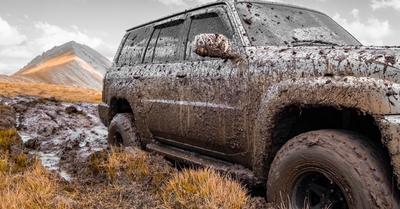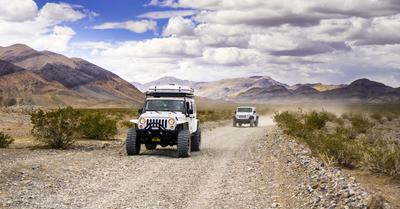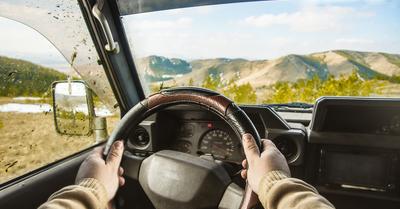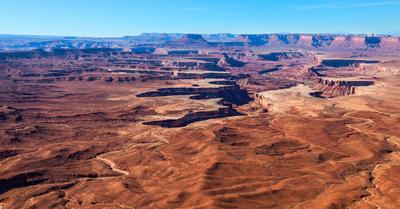Everyone gets stuck from time to time, but learning the right skills and having the right tools can make it an easy fix.
The best ways to get unstuck are with careful driving, utilizing 4-High and 4-Low, getting pulled out by another car or a winch, and using an escaper tool. Stuffing sticks and logs under the tires or digging yourself out can also work.
In this article, we’ll cover the most common and effective ways to get unstuck in the mud or other loose material. Additionally, we’ll cover some of the most common reasons why people get stuck and a few tips to prevent it in the future.
The information in this article is the culmination of years of first-hand off-roading experience.
This article may contain affiliate links where we earn a commission from qualifying purchases.
Why do Vehicles Get Stuck Off-Road?
There are numerous reasons why cars and trucks get stuck off-road. Typical scenarios, such as sinking deep into the mud, aren’t even the most common. The easiest way to get a car stuck off-road is to high-center it and lift the drive wheels off the ground. Here are a few reasons why vehicles get stuck off-road.
High-Center
If your vehicle is a four-wheel drive, your front wheels can help drag the vehicle off the high center. However, sometimes you’ll start spinning your front wheels too—then you’re really hosed.
Mud
Mud is a frequent source of problems off-road. Sticky mud, like clay, is simultaneously extremely slippery. It fills up your tires and turns the tread useless, causing your tires to spin endlessly with no progress.
Snow and Ice
Snow and ice are easy to get stuck in. Typical tires have absolutely no traction on ice, and deep snow can literally bury a vehicle and make it impossible to move forward or backward.
Sand
Sand causes problems similar to snow, except without the slipperiness. Cars get stuck in the sand when their tires dig in too deep, and the vehicle gets buried and can’t move in either direction without going deeper.
Loose Ground
Loose ground can cause a vehicle to get ‘directionally stuck’ when the tires spin instead of moving the vehicle forward. This is common when you’re driving up a hill, as the ground is too loose to continue driving without coming loose under the wheels.
Tires and Traction
Tires play a huge part off-road, and they can be the difference between a car that gets stuck and one that doesn’t. There are different kinds of tires for different types of terrain, and no one tire performs perfectly in all situations.
Mud tires work best in mud because they have wide tread blocks that pack with material and provide traction. Tires for sand grab confidently and help propel the vehicle forward, and snow tires have aggressive sipes to increase traction on wet surfaces.
Using the wrong kind of tires can be a recipe for disaster, especially in mud and snow. You can get away with using highway tires or all-terrains on reasonable off-road trails, but serious conditions require serious tires. Don’t try to go mud-bogging or snow trail driving without purpose-made tires.
Does 4WD Matter Off-Road?
Yes, 4WD matters off-road. Having 4WD is the best thing you can do to avoid getting stuck, provided you don’t drive like you can’t get stuck. Four-wheel-drive vehicles can traverse all kinds of terrain, but 4WD is rendered mostly useless if the driver is careless or you’re using the wrong kind of tires.
It’s important to differentiate between 4WD and AWD (all-wheel-drive) off-road. Some AWD vehicles, like the Subaru Forester, are suitable for some off-road driving but not serious trail rides. A true part-time or full-time 4WD system is significantly more robust than a car or compact SUV AWD system and designed for driving off-road.
How to Avoid Getting Stuck in a 2WD Vehicle
2WD, or two-wheel-drive vehicles, aren’t guaranteed to get stuck just because their power goes to the rear wheels. Some terrain, like sand, is ideal for well-equipped 2WD vehicles like PreRunner trucks.
4WD didn’t exist for a long time, yet 2WD cars and trucks traveled across the planet with excellent success. The Ford Model T is a great example, and anecdotal testing showed that the 100-year-old 2WD car performed better off-road than a Land Rover.
If you have a 2WD and need to use it off-road, consider swapping the rear tires to something with an aggressive tread. Farmers used to do this on their 2WD trucks during the 40s, 50s, and 60s, and the strategy still works today.
Additionally, drive carefully and use speed to your advantage. If you see a mud hole at the bottom of a hill, try to hit it with enough momentum to get out on the other side. You’ll have better luck if you turn traction control OFF prior to entering a situation where you might need to spin the tires.
How to Get Unstuck in a 2WD or 4WD Vehicle
There are a few ways to get unstuck in a vehicle, and the best method depends on why you’re stuck. If you’re stuck in mud or loose material, don’t sit there and spin the tires once you stop moving. You might make some progress, but you’ll probably just dig yourself in deeper.
The first thing to try is going in reverse. If you’re having no luck moving forward, try moving backward. If you’re in a 4WD vehicle and still in 2WD, the solution is obvious. Try 4H and see if that helps. If not, switch to 4L. 4-Low puts more power on the front wheels and changes the ratio, allowing you to stop spinning the rear wheels or crawl.
If that doesn’t work, you’ll need to get out of the car and find a way to get traction. One way is to stuff some debris in front of your tires. This acts as a floating roadway and allows you to get a bit of forward momentum. Plywood is usually too slippery, but thick sticks, rocks, or logs might work. Some people have even used camping garbage or tarps with varied success.
If you still can’t get out, you can try digging around the wheels with a shovel or entrenching tool. You can also add dry dirt to the area around the tires, which may be enough to get you going again. But sometimes, tools will be necessary. Here are some tools and accessories that can help any vehicle get unstuck.
1. Use an Escaper
An escaper is an invaluable tool, especially for two-wheel-drive vehicles. This piece of plastic looks like an oversized rough-cut chisel, and it’s designed to provide a piece of high-grip roadway for you to drive upon.
To use an escaper, position it in front or behind the tire and wedge it in. Then, drive slowly in that direction until your tire bites and rides up onto the escaper. Simple enough, and they actually work.
2. Winch
A winch is an excellent off-road accessory to have. It’s useful for pulling yourself out, and it can also help you pull other people out without risking getting stuck yourself. If you’re alone, tie the winch to a thick tree and carefully pull yourself forward until you can drive.
Winches must be used carefully, but they have a great success rate at getting people unstuck. You can also hook up the cable to another vehicle (preferably one that’s not stuck) and pull yourself out that way.
3. Off-Road Jack
An off-road jack allows you to lift one end of the vehicle up off the ground. The jack itself isn’t going to get you completely unstuck, but it does allow you to put solid material under the tire to get you moving again. An off-road jack is an inexpensive tool that can also help you safely change a tire or make repairs off-road.
What to Do if You Can’t Get Unstuck
Yikes, so you’re really stuck. Don’t panic yet—unless you’re in quicksand or swamped in a bog, there’s usually something you can do to get unstuck. Spend some more time digging around the wheels and try to get out the way you came in.
Force whatever you can under the tires to get momentary traction. If your wheels keep slipping on the new surface, try digging out the tread or washing the mud off to give it a chance to bite.
If everything fails, you’ll need outside help. Call a park ranger or a buddy and the non-emergency police line if all else fails. If there’s no service, you’ll have some problems, but somebody usually comes by eventually on popular off-road trails.
Next, we’ll cover a few off-roading tips that can help prevent you from getting in this situation to begin with.
Tips For a Better Off-Road Experience
Getting stuck is a bummer, and it’s a big problem if you’re all alone and don’t have the tools to free your vehicle. Here are a few off-roading tips that can help you have a better time and make getting unstuck easy.
1. Bring a Buddy
An extra set of hands is always helpful, but an extra set of wheels is better. If you have friends with off-road vehicles, travel in a convoy of a few trucks. This will always leave someone available to help pull you out or take you back to get the tools you need.
2. Come Prepared
Always come prepared with the tools you’ll need for your specific environment. Compared to the price of the vehicle, escapers and winches aren’t that pricey, and a set of tow straps should always be behind your seat or in the toolbox.
3. Evaluate the Trail
Know before you go. Where does this road lead? Have you been on it before? Have you been on it before during this particular season? Off-road trails can change, but knowing the route and its conditions can save you from getting stuck needlessly.
4. Learn to Drive Off-Road
Everyone—we mean everyone—has gotten stuck at some point, but experienced drivers get stuck way less often. Driving off-road is a high-level skill that needs to be developed over time, so having an experienced off-roader with you can be a big plus. At some point, you’ll learn what a bad road looks like before you drive on it.









